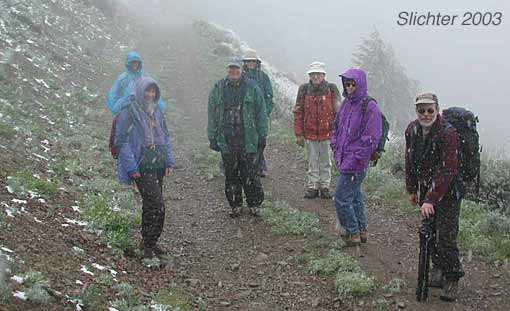
Malheur National Forest

Dixie Butte is a cone-shaped butte rising to an elevation of 7592' amidst dense conifer forests about 26 miles northeast of John Day, Or. Although volcanic in appearance, it actually consists of eroded prehistoric seafloor sediments some 200-250 million years old. A forest service lookout, manned during the summer, is located at its top, and a rough dirt road leads to the summit.
Reach Dixie Butte by driving on US Highway 26, proceeding steeply uphill and northeast from Prairie City, OR or proceeding east from Baker City, OR or Ontario, OR. Upon reaching the Dixie Summit, one turns north onto dirt roads and proceeds uphill about 5 miles on forest road 2610. Low bottom cars will need to beware. It is easy to bottom out on the numerous, baseball-sized rocks on the road. At the base of the butte, you will come to a clearing, with a road descending the southwest slopes of Dixie Butte. This is a good spot to park. The rest of the road is not suitable for most passenger cars due to its steepness, loose rocks and rock outcrops. 4WD would be recommended.
Access by vehicle is limited from late May (at the earliest) to late Fall due to snowfall. I'm guessing that good wildflower displays normally begin in mid to late June extending into July. Driving time from John Day to the parking spot on Dixie Butte is about 40-45 minutes.
One can amble either along the road (1.2 miles to the summit) or on the slopes to the east of the road, viewing many wildflower species (See list below.). The summit, especially the western edge sports numerous natural rock gardens, and the 360 degree views include the Strawberry and Aldrich Mts to the southwest, the Monument Rock Wilderness to the southeast, the drainage of the Middle Fork John Day River immediately below to the north, with views further northeast to the Vinegar Hill and Indian Rock Scenic Area and the Elkhorn Mts.
Dixie Butte affords a good selection of wildflowers due to the varied habitat. The summit supports rock garden plants such as glandular paintbrush (Castilleja glandulifera), linear-leaved paintbrush (Castilleja liniariifolia), woolly goldenweed (Stenotus languinosus), woolly groundsel (Packera cana), Piper's buckwheat (Eriogonum flavum), alpine fleeceflower (Polygonum phytolaccaefolium), alpine alumroot (Heuchera cylindrica var. alpina), Wallowa penstemon (Penstemon spatulatus) and cutleaf fleabane (Erigeron compositus). The dry lower slopes support such species as Eaton's villous daisy (Erigeron eatonii), tapertip penstemon (Penstemon attenuatus), white coiled-beak lousewort (Pedicularis contorta var. contorta), giant green gentian (Frasera speciosa), Holboell's rockcress (Arabis holboellii), prickly sandwort (Eremogone aculeata), and Tolmie's onion (Allium tolmiei). The lower forests support a different set of plants including California jacob's ladder (Polemonium californicum).
June 18 & 22, 2003: Dixie Butte, Malheur N.F.
July 4, 2002 Dixie Butte